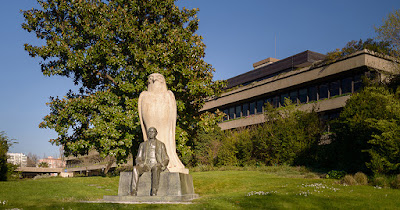What not to miss at the Museu Calouste Gulbenkian
Based on the private collections of oil millionaire Calouste Gulbenkian, this is one of the most important Lisbon’s museums.
The project for the Calouste Gulbenkian Foundation and Museum, inaugurated in 1969, was the result of a limited competition that took place from, 1959 to 1960 between three teams of architects.
The permanent exhibition galleries are distributed in chronological and geographical order to create two independent circuits within the overall tour, in a collection that now totals over 6,000 pieces from all over the world and dating from antiquity until the early twentieth century (including examples
from ancient Egypt, ancient Greece, Babylonia, Armenia, Persia, Islamic Art, Europe, and Japan).
Calouste Gulbenkian revealed his passion for art early, reflecting in part his origins in Cappadocia--a major crossroads of religions and art--and Constantinople--another crossroads of civilizations and the capital of the Romans, Greeks, and Ottoman Turks.
Throughout his life, he assembled an eclectic and unique collection that was influenced by his travels and his personal taste, and sometimes involved lengthy and complex negotiations with the leading experts and specialist dealers.
It was hard to find the Top 5 features not to miss when visiting this wonderful museum but, here they are.
1 – Eastern Islamic Art
A large gallery shows a wide-ranging collection of manuscripts, carpets, textiles and ceramics, from Persia, Turkey, Syria, the Caucasus and India, dating from the twelfth to the eighteenth centuries.
2 – Diana Statue
This masterpiece of French eighteenth-century sculpture, by Houdon gives Diana an original treatment, presenting her naked and running, in contrast with the static and idealized Diana of his predecessors, dressed in a tunic as a symbol of virginity.
3 - St. Catherine and St. Joseph
Two paintings by the 15th-century Flemish master Rogier van der Weyden are believed to be parts of an altarpiece that was dismantled for unknown reasons been the third element is in London’s National Gallery.
4 – Boy Blowing Bubbles
This Édouard Manet painting from 1867 which the theme is, Vanitas, or the fleeting nature of life symbolized by the soap bubbles, was given a unique interpretation by the author.
5 – Lalique Collection
Gulbenkian was a close friend of the French Art Nouveau jeweler René Lalique (1860-1945) and its collection of works is quite exceptional for the quality of the jewelry and other objects, particularly the glass, which, because of its quality and consistency is considered to be quite unique.
The project for the Calouste Gulbenkian Foundation and Museum, inaugurated in 1969, was the result of a limited competition that took place from, 1959 to 1960 between three teams of architects.
The permanent exhibition galleries are distributed in chronological and geographical order to create two independent circuits within the overall tour, in a collection that now totals over 6,000 pieces from all over the world and dating from antiquity until the early twentieth century (including examples
from ancient Egypt, ancient Greece, Babylonia, Armenia, Persia, Islamic Art, Europe, and Japan).
Throughout his life, he assembled an eclectic and unique collection that was influenced by his travels and his personal taste, and sometimes involved lengthy and complex negotiations with the leading experts and specialist dealers.
It was hard to find the Top 5 features not to miss when visiting this wonderful museum but, here they are.
1 – Eastern Islamic Art
A large gallery shows a wide-ranging collection of manuscripts, carpets, textiles and ceramics, from Persia, Turkey, Syria, the Caucasus and India, dating from the twelfth to the eighteenth centuries.
2 – Diana Statue
This masterpiece of French eighteenth-century sculpture, by Houdon gives Diana an original treatment, presenting her naked and running, in contrast with the static and idealized Diana of his predecessors, dressed in a tunic as a symbol of virginity.
3 - St. Catherine and St. Joseph
Two paintings by the 15th-century Flemish master Rogier van der Weyden are believed to be parts of an altarpiece that was dismantled for unknown reasons been the third element is in London’s National Gallery.
4 – Boy Blowing Bubbles
This Édouard Manet painting from 1867 which the theme is, Vanitas, or the fleeting nature of life symbolized by the soap bubbles, was given a unique interpretation by the author.
5 – Lalique Collection
Gulbenkian was a close friend of the French Art Nouveau jeweler René Lalique (1860-1945) and its collection of works is quite exceptional for the quality of the jewelry and other objects, particularly the glass, which, because of its quality and consistency is considered to be quite unique.



Comments
Post a Comment